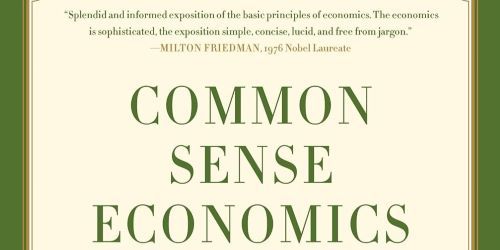Extras: Robert Lawson on Educating for Economic Freedom and James Gwartney's Legacy
March 5, 2024

Temnick echos Robert Lawson's appreciation for James Gwartney and offers questions for reflection on the current state and legacy of economic education.

Temnick echos Robert Lawson's appreciation for James Gwartney and offers questions for reflection on the current state and legacy of economic education.
I had the great fortune of meeting James Gwartney. We sat together at a conference and a dinner that followed. I don’t remember exactly what we talked about, I do remember his warmth, kindness and humor. At first, I wasn’t aware that he was completely blind although he had a cane propped beside his chair. He was so grateful that I offered to bring him tea on the breaks and added the sugar for him according to his direction. Jim’s visual impairment and the challenges of navigating ordinary tasks stuck with me. I’ve never forgotten that encounter with a truly exceptional human being. Of course, I also had him sign my copy (first edition) of Common Sense Economics, which was newly published and the topic of his presentation on that day.
Listen to the episode here.
Listen to the episode here.
In this episode of the Great Antidote, Julianne Sellgren interviews Robert Lawson, a close colleague and dear friend of the now deceased James Gwartney. Lawson’s gracious account of his colleague, esteemed economist, researcher, author, presenter, and master economic educator is heart-warming. Lawson was in awe of his friend’s Christian faith, exceptional productivity, and positive outlook. Lawson claims that Jim “was the only person I think in my life that quite genuinely made me a better person just by watching him”. Lawson recounts stories of Gwartney’s incredible memory and ability to utilize technology to flourish. He chose never to complain about his disability and instead mastered technologies that led to incredible achievements in his field. Lawson, with coauthor Richard Vedder, also wrote the Wall Street Journal obituary for Gwartney.
Sellgren delves into questions about the project that Lawson worked on with Gwartney in response to a question posed by Milton Freidman about how to measure freedom. Lawson began this project as a graduate student and has seen the project through several expansions. It now includes 165 countries and is enormously popular and widely cited. You know it as the Fraser Institute’s Economic Freedom of the World Index. This compilation of over sixty measurements for each of the countries tracked has become a reliable data set for hundreds of studies that have enriched journal articles, informed policy makers, and enabled economists to present empirical evidence that links free market economies to economic growth and prosperity.
These questions might guide discussion about additional points of the discussion:
1. Lawson mentions the difficulty in measuring and rating property rights across countries.. Often referred to as a cornerstone institution in free market economies, how might you describe the significance of high and low ratings in the property rights category?
2. The United Arab Emirates’s (UAE) zero marginal tax rate (MTR) is enticing. What costs and consequences do you imagine accompany this zero MTR for the oil-rich nation?
3. In light of recent increases in protectionist measures and regulations as well as weakened property rights, how does Lawson argue for optimism? Do you share it?
4. What changes to economic education can we attribute to James Gwartney? If you studied economics, were you a student who benefitted from the modern trend of engaging textbooks or were you part of the generation that can remember the smell and weight of the Samuelson tome?
Related Great Antidote episodes
Kerrianne Lawson on Equal Economic Freedoms
Vincent Geloso on Global Inequality
Kenneth Elzinga on Teaching Economics
Alice Temnick on Teaching, Learning, and Adam Smith's Education
Kerrianne Lawson on Equal Economic Freedoms
Vincent Geloso on Global Inequality
Kenneth Elzinga on Teaching Economics
Alice Temnick on Teaching, Learning, and Adam Smith's Education
Related content
Economic Freedom by Robert A. Lawson, at Econlib
The Road to Serfdom is Paved by Conservatives by Veronique de Rugy, at Econlib
The 1918 Pandemic and Economic Freedom by Pierre Lemieux, at Econlib
How Should Econ 101 be Taught? By Donald Boudreaux, at Econlib
Kimberly Clausing on Open and the Progressive Case for Free Trade, EconTalk
William Bernstein on the History of Trade, EconTalk
David Autor on Trade, China, and U.S. Labor Markets, EconTalk
Economic Freedom by Robert A. Lawson, at Econlib
The Road to Serfdom is Paved by Conservatives by Veronique de Rugy, at Econlib
The 1918 Pandemic and Economic Freedom by Pierre Lemieux, at Econlib
How Should Econ 101 be Taught? By Donald Boudreaux, at Econlib
Kimberly Clausing on Open and the Progressive Case for Free Trade, EconTalk
William Bernstein on the History of Trade, EconTalk
David Autor on Trade, China, and U.S. Labor Markets, EconTalk
For teachers
AdamSmithWorks Teaching Resources Trade Toolkit
The entries on Free Trade (by Alan S. Blinder) and Protectionism (by Jagdish Bhagwati) in the Concise Encyclopedia of Economics
AdamSmithWorks Teaching Resources Trade Toolkit
The entries on Free Trade (by Alan S. Blinder) and Protectionism (by Jagdish Bhagwati) in the Concise Encyclopedia of Economics